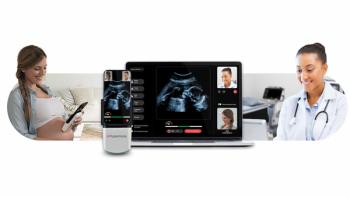
Ultrasound: diagnostic aid or foible, political tool or entertainment?
To those who sit at an ultrasound console, the probe they twist and slide into position is the means to an end. For most, it is a clinical end. But, increasingly, ultrasound is being mobilized not to diagnose but to entertain and even to persuade.
To those who sit at an ultrasound console, the probe they twist and slide into position is the means to an end. For most, it is a clinical end. But, increasingly, ultrasound is being mobilized not to diagnose but to entertain and even to persuade.
At pregnancy clinics across the U.S., ultrasound is being pressed into service to demonstrate that an early-stage fetus is recognizable - that it has arms and legs and a face.
These are the clinchers for women on the fence about having an abortion, the women who visit pregnancy clinics such as the Asheville Pregnancy Support Services in North Carolina. This center employs medical ultrasound to make the point that the developing fetus is not just a blob of tissue, according to Deborah Wood, CEO of the Asheville center.
The modality is used, she said, to determine whether the pregnancy is viable and whether abnormalities are present. The staff has no agenda, she told me.
"We do not try to influence our clients' decisions in any way, shape, or form," she said. "We want them to have all the facts."
They let sonography do the talking. Wood described how the fetus may be sucking a thumb or "waving."
"They can see hands and legs and a head," she said. "At eight weeks, this is undeniably a child."
Wood and her staff work at one of more than 500 pregnancy centers in North America that have begun offering ultrasound, according to Care Net, a nationwide chain of 1100 centers. Its website urges visitors to volunteer, donate, and pray. The goal, according to spokesperson Kristen Hansen, is to provide women with comprehensive information about pregnancy options. Ultrasound is an important source of that information, she told me.
The political application of this technology, for the most part, has evaded detection or, perhaps more aptly, recognition. It is a consequence of the blinders we wear, as we consider medical technologies within the narrow confines of only what we expect from them.
Ultrasound, often the first step in a diagnostic path, is revered as eminently safe because of its lack of ionizing radiation. Its Hippocratic compatibility has made the technology attractive outside the purely diagnostic and has created a cottage industry for devices that allow expectant parents to eavesdrop on the fetal heart and for prenatal boutiques to produce "keepsake" sonograms, in the form of video clip screen savers and wallet-size snapshots, for their expectant clients.
Depending on your perspective, some may argue that this use of ultrasound is no more - or less - a danger than its use as a persuasive tool in the tug of war between prolife and prochoice forces.
Our perceptions can influence how we view ultrasound in other ways, creating other risks. Again, the most affected is the unborn. In the August issue of Ultrasound, Dr. Hylton Meire, a consultant radiologist to King's College Hospital in the U.K., claims that the usefulness of fetal "nuchal thickness" as a technique for attempting to diagnose Down's syndrome using obstetric ultrasound is overstated. In his opinion, reliance on this surrogate marker may result in the "loss" of normal babies.
It is a euphemism worthy of elaboration. Positive tests may lead to amniocentesis, which reportedly carries a one in 200 risk of miscarriage. Yet Meire argues that there are no valid data showing any benefit from the 18 to 20-week ultrasound test for Down's syndrome. The world's major medical associations agree, he said. And yet the test is performed.
The irony that a diagnostic test done with ultrasound potentially can lead to the "loss" of a healthy fetus is not likely to escape those at Care Net centers and other pregnancy centers that use ultrasound to convince women to continue their pregnancies.
But this spectrum of ultrasound uses, from diagnostic to recreational to political, illustrates more than that. It shows how people choose to use ultrasound and what they do with the information. In this way, ultrasound is as much a reflection of us and our society.
Newsletter
Stay at the forefront of radiology with the Diagnostic Imaging newsletter, delivering the latest news, clinical insights, and imaging advancements for today’s radiologists.




























